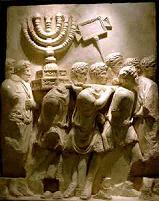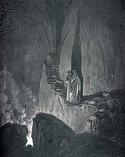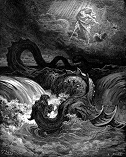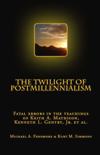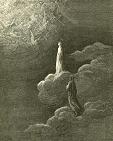The General Resurrection and
The Book of Daniel
In this
article we explore the general resurrection: what was it and
when did it occur?
The Five Deaths Identifiable in Scripture
In order to
identify what the general resurrection was or consisted in, it
will be useful to briefly survey the five deaths identifiable in
scripture, so that we can safely rule out what it was not.
1)
Moral/Spiritual death.
Man was created in the image of God; he participated in
the divine image and likeness by the indwelling of God’s Spirit
(inspiration – Heb. “neshamah”, Strong’s # 5397) breathed into
our first ancestor at his creation (Gen. 2:7). This inspiration
allowed man to rise above his carnal nature. When man sinned, he
lost the indwelling of God’s Spirit (neshamah).
He became carnal, sold under sin.
He possessed the ability to see and to choose right from
wrong, but his affections so far inclined in favor of his flesh,
that he was estranged from God in his heart, and followed after
his lower appetites.
Paul describes this, saying, “the flesh lusteth against the
Spirit, and the Spirit against the flesh: and these are contrary
one to the other: so that ye cannot do the things that ye would”
(Gal. 5:17; cf. Rom. 7:14ff).
Man’s carnality is treated as a type of “death” in
scripture from which man must be awakened or raised.
Thus, Paul says in Ephesians “Awake thou that sleepest,
and arise from the dead, and Christ shall give thee light” (Gal.
5:14).
Here we see that moral estrangement from Christ is
characterized as a type of death, from which man is raised by
turning from sin to Christ.
2)
Legal/Juridical death.
This is best comprehended as the sentence handed down by
God for all that commit sin (the idea of imputed sin or
condemnation is unbiblical and rejected).
All that sin come under the sentence of eternal death,
and are treated as dead, or as “good as dead” in contemplation
of law. Paul alludes
to this death when he says “And you hath he quickened, who were
dead in trespasses and sins...God, who is rich in mercy, for his
great love wherewith he loved us, even when we were dead in
sins, hath quickened us together with Christ, (by grace ye are
saved;) and hath raised us up together, and made us sit together
in heavenly places in Christ Jesus” (Eph. 2:1, 4-6).
We take the phrase “dead in sins” to signify that we were
under judgment of sin and the sentence and punishment of eternal
death. However,
unwilling that any perish, God gave his Son to be a propitiation
for our sins (“Christ died for all; salvation is freely
available to all; and God wants all to be saved”).
The sentence being satisfied by Jesus’ substitutionary
death and atoning sacrifice, we are acquitted of guilt and
“quickened” together with Christ.
We thus pass from a condition of legal and juridical
condemnation and death, to one of justification and life by the
obedience of faith and power of Christ’s cross.
3)
Physical death.
Physical death was the result of Adam’s being bared from
the tree of life (Gen. 3:22-24).
It is not the ultimate penalty for sin, but it is clearly
one of its immediate consequences and a perquisites to eternal
death: “In the sweat of thy face shalt thou eat bread, till thou
return unto the ground; for out of it wast thou taken: for dust
thou art, and unto dust shalt thou return” (Gen. 3:19).
Since physical death was the immediate doom brought in by
sin, and bespoke the greater doom of eternal death that
followed, it is from physical death that the promise of
resurrection was given.
This promise was made in veiled, poetic terms when God
said that the woman’s seed would bruise the head of the serpent,
signifying that Jesus would crush the power of sin and death by
his cross and resurrection (Gen. 3:15).
It is to physical death Martha referred when Lazarus
died, saying, “I know that he shall rise again in the
resurrection of the last day” (Jn.
11:21).
The resurrection of the last day was therefore from
physical death.
Similarly, it is to the physically dead the Greek collectively
refers when it describes Jesus’ resurrection saying he was
raised from “among the dead” (Lk. 24:46; cf. Acts
17:32).
Jesus was the firstfruit of the general resurrection.
But Jesus’ resurrection was from among the physically
dead. Therefore, the general resurrection is from physical
death. However, a
resurrection from physical death does not imply a resurrection
to physical life.
Our inheritance is in heaven, where physical bodies cannot
enter. Flesh and
blood cannot inherit the kingdom of heaven (I Cor. 15:50,
51; cf. 35-44).
The natural body shed at death is replaced by a spiritual
body suited to ethereal realms above – immortal, intangible, and
immaterial.
4)
Hadean death.
Death and Hades are closely associated in scripture.
The phrase “death and Hades” occurs with some frequency
in Revelation, showing that these were inseparably related (Rev.
1:18; 6:8; 20:13,
14; cf. I Cor. 15:55).
Called “Sheol” in the Old Testament, Hades was to the
soul or spirit of man what the grave was to the body.
The soul could not enter the presence of God in heaven
without the atoning sacrifice of Christ, so the dead were
sequestered in Hades until the general resurrection.
The righteous dwelt in a place of comfort called
“paradise” or “Abraham’s bosom” (Lk. 16:23;
cf.
23:43;
II Cor. 12:4), the wicked dwelt in a place of doom and
punishment called “Tartarus” (Lk.
16:23, 24; II Pet.
2:4). Jesus’ spirit was in Hades with the repentant thief after
their death upon the cross (Lk.
23:43;
Acts
2:27).
The inherent connection in previous times between death
and Hades meant that resurrection from physical death was also a
resurrection from Hades.
(See Rev. 20:11-15; cf. I Cor. 15:55.)
Hadean death was the last enemy standing between the
saints and entrance into the presence of God in heaven.
Hadean death was done away at the general resurrection.
The saints now go directly to heaven upon decease, the
lost to eternal punishment.
5)
Eternal death.
The wages of sin is death (Rom. 6:23).
Death was the punishment annexed to sin from the very
garden (Gen. 2:17).
But physical death was not the ultimate consequence of sin.
Rather, physical death entered because access to the tree
of life was removed, lest man eat of the tree of life and live
forever a sinner (Gen. 3:22-24).
For the righteous, physical death held the promise of
resurrection to eternal life; for the alien sinner, physical
death forebodes eternal doom.
Although we do not believe the soul of man is immortal
(this was a Greek concept connected with the doctrine of
reincarnation in which the soul was born to earthly life anew
after a 1000 year sojourn in Hades), the spirit of man does
survive physical death.
Those who die outside of Christ are sentenced to Gehenna,
also called the “lake of fire,” or “second death” (Matt.
23:33; Rev. 20:14,
15). Gehenna, or the
Valley of
Tophet,
was a valley beyond the walls of
Jerusalem.
It was the place where the corpses of185,000 Assyrians that
perished before the walls of
Jerusalem
were buried and burned (Isa. 30:31-33; 37:36).
Josephus reports that over 600,000 Jews were cast into
Gehenna from the famine during the siege of
Jerusalem,
where their bodies were flyblown and putrefied, and eaten by
kites and dogs. This
is the meaning of the phrase “their worm dieth not and the fire
is not quenched” (Isa. 66:24; Mk. 9:44,48)
viz., like a garbage dump, the maggots and fires
assigned to consume the wicked are never quenched, but feed
continuously upon those that neglect to lay hold upon salvation.
Having
reviewed the various uses made of the term “death” in scripture,
it should be clear that the general resurrection consisted
exclusively in resurrection from physical death and Hades.
Only Hadean death was done away by the resurrection.
Affirming any other “death” was done away will result in
Universalism. Test it for yourself and see: if we say physical
death was done away, then all men will live forever.
If we say legal and juridical death was done away, then
all men are justified.
If we say moral and spiritual death was done away, then
all men are made holy and pure. If we say eternal death was done
away, then the penalty of sin has been removed.
Thus, only Hadean death was destroyed by the general
resurrection. See
Rev. 20:14.
When was the Resurrection?
So much for
the “what” of the general resurrection. Let’s talk about the
“when.” When did the
prophets say the general resurrection would occur?
It is clear
that the prophets and the expectation of the Jews was that the
coming of the Messiah would herald the resurrection of the dead.
This was the promise made to Adam and Eve, and it was the
constant theme traversing the centuries between the fall and the
appearance of Christ.
Hosea looks to the defeat of death when he says “I will
ransom them from the power of the grave (Heb. Sheol); I will
redeem them from death: O death, I will be thy plagues; O grave
(Heb. Sheol), I will be thy destruction: repentance shall be hid
from mine eyes” (Hos. 13:14).
Similarly, Isaiah says “He will swallow up death in
victory” (Isa. 25:8).
Both of these passages are cited by Paul with expectation
of imminent fulfillment (I Cor. 15:54,
55). Thus, it would
be very strange if the promise announced by the prophets that
was to attend the appearance of the Messiah was still
languishing 2000 years after Christ appeared!
But when would this occur?
And since it would transpire upon the other side of
eternity, in the realm of the spirit, not this side of eternity
in the realm of the flesh, how can it be known if and when it
was fulfilled? The
most precise time statements are provided by the prophet Daniel
in his last vision.
Daniel and the Resurrection
Daniel is a
book of timelines unto the kingdom and coming of Christ.
It is also a timeline unto the general resurrection.
Daniel’s prophecies span four world empires that would
rise and wane, and provide a gauge by which men could know when
the Messiah would appear.
These kingdoms, described principally in chapters 2 and
7, were
Babylon,
Mede-Persia,
Greece,
and
Rome.
But as Rome did not fall until A.D. 476 – long past the
appearance of Christ – a second timeline of 490 prophetic years
was provided to further delimit the critical period (Dan.
9:24-27). These 490 prophetic years began with the decree to
rebuild
Jerusalem’
walls and gates after the captivity on the one hand (454 B.C.),
and concluded with the destruction of
Jerusalem
by Titus (A.D. 70) on the other.[1]
The events traversing these are described in minute
detail in Daniel’s final vision, recorded in chapters 10-12.
The vision
begins with the Persian monarchy, the rise of Alexander the
Great, and the four kingdoms or divisions that rose out of his
empire upon Alexander’s death (Dan. 11:1-4).
The period of the Greek Ptolemaic dominion in Egypt to
the South and the Seleucid dominion in Syria to the North of
Judea are developed at length (Dan. 11:5-20), followed by the
persecution of Antiochus Epiphanes and the exploits of the
brothers Maccabee (Dan.
11:21-39).
Dan. 11:40-45 introduces the Roman power which came to
dominate the region beginning with the defeat of Antiochus III
the Great at Thermoplyae (191 B.C.) and Magnesia (190 B.C.), and
the treaty of Ampanea (188 B.C.), but attained the greatest
gains under Pompey, who defeated Mithridates, king of Pontus,
followed by the conquest of
Judea
(63 B.C.). Julius
Caesar is the king who gains control of
Egypt, but “comes to his end with none to help him” (v. 45).
Caesar was followed by Octavian Augustus, in whose time
Christ was born into the world (Lk. 2:1).
Daniel refers to appearance of the Messiah, saying, “At
that time shall Michael stand up, the great prince that standeth
for the children of thy people” (Dan. 12:1; cf. Rev. 12:7-11).
The crucifixion of Christ was addressed in Dan. 9:24-27 where
the Messiah was “cut off,” so Daniel does not pause to repeat
Christ’s earthly ministry here, but rushes ahead to the “great
tribulation.”
“And
there shall be a time of trouble, such as never was since there
was a nation even to that same time: and at the time thy people
shall be delivered, every one that shall be found written in the
book. And many of them that sleep in the dust of the earth shall
awake, some to everlasting life, and some to shame and
everlasting contempt” (Dan. 12:1, 2).
Here is the
resurrection of the dead, tied to the time of trouble, or “great
tribulation.” The great tribulation consisted in the persecution
under Nero (A.D. 64-68), the Roman civil wars that followed
Nero’s death (A.D. 68-70), and the destruction of
Jerusalem
(A.D. 66-70). Jesus
specifically mentioned the great tribulation in the context of
the fall of
Jerusalem
in A.D. 70 and mentions the prophecy of Daniel by name (Matt.
24:15-21). Jesus
said “This generation shall not pass, till all these things be
fulfilled” (Matt. 24:34; cf. Matt. 23:34-39).
Thus, the resurrection would come upon the heels of the
fall of
Jerusalem.
The time frame established by Jesus occurs also in
Daniel. Daniel did
not understand the vision and asked when the things described
would come to pass.
The angel told him “unto a time, times, and an half; and when he
shall have accomplished to scatter the power of the holy people,
all these things shall be finished” (Dan. 12:7).
This points to the destruction of
Jerusalem
at the conclusion of the 3 ½ war with
Rome.
This is further corroborated by reference to the
cessation of the daily sacrifice and the setting up of the
abomination of desolation (Dan. 12:11-13).
The daily sacrifice refers to the sacrifice offered twice
daily for Caesar, which the Jews rejected and which Josephus
says was the “true beginning” of the war.
1290 days would transpire from the taking away of
Caesar’s sacrifice to the setting up the abomination of
desolation (the Roman force assembled by Titus).
This occurred when Titus marched from
Egypt
to Caesarea
to assemble his forces.
The 1335 days would be the 45 days more before Titus set
up camp before
Jerusalem
during Passover, trapping over a million Jews within the city
who would perish almost to a man.
“All these things” would be fulfilled by the time
Jerusalem
was razed, including the resurrection of the dead:
“But go thou thy way till the end be: for thou shalt
rest, and stand in thy lot at the end of the days” (Dan. 12:13).
Daniel would be raised at the end of the time specified,
together with the rest of the dead.
Dan. 12 is
the shortest and surest route to establish the time of the
resurrection. In
fact, the whole issue of the timing of Christ’s second coming
can just about be debated upon the strength of this one verse.
When my friend Don Preston debated Mac Deaver here in
Carlsbad
in 2008, Deaver avoided any discussion of Dan. 12, despite Don’s
repeated attempts to get him to give us his view on the passage.
Don’s comment was that Deaver “didn’t even breathe on
it.” That is, he
could not be induced to offer one word by way of explanation how
the resurrection is still future when Daniel so plainly placed
it the fall of
Jerusalem.
This same studied avoidance of Daniel 12 is true of
Gentry, Mathison, Strimple, and others who, confronted with the
simple truth of the time for the general resurrection, cannot
square it with their preconceived ideas. In their book “When
Shall These Things Be? – A Reformed Response to Hyperpreterism”[2] not one of the authors had
the courage to attempt an explanation.
For example, Mathison, editor of the book, affirms that
Dan. 12:2 is talking about individual resurrection. Yet, when he
quotes Dan. 12:5-7, which states that all these things would be
fulfilled when the power of the holy people was shattered,
Mathison weakly offers “the specific meaning of ‘a time, times,
and half a time’ is not clear.”[3]
But if the 3 ½ years alluded to by this verse escapes
Mathison, surely the “shattering of the power of the Jews”
cannot! Isn’t,
rather, that Mathison’s preconceived ideas prevent him from
receiving the obvious meaning of the text?
James Jordan, in his commentary on Daniel, surveys no
fewer than six possibilities. He says that he believes there was
a resurrection (“ascension”) of Old Testaments saints to heaven
to reign with Christ in AD 70, and affirms that Dan. 12:13
appears to point to that fact.
However, he rejects the idea that the resurrection of
Dan. 12:2 refers to A.D. 70 for no more reason than it does not
square with his understanding of the Millennia in Revelation 20.
Thus, the obscurities of Revelation prevent him from
receiving the plain teaching of Daniel!
In the end, Jordan avoids committing to any certain
answer – equivocating instead that maybe a spiritualized
evangelic, teaching ministry is alluded to - a clear indication
that the book is closed to all who try to force it into a
futurist paradigm.[4]
Conclusion
The general
resurrection consisted in the release of the accumulated souls
in Hades. The prophets taught that the resurrection would appear
with the Messiah. Daniel sets the time for the resurrection at
the destruction of
Jerusalem,
A.D. 70.
[1]
There was a gap of approximately 36 years marking the
period between Christ’s ascension and his return.
[4]
James Jordan, The Handwriting on the Wall
(American Vision, 2007), pp. 615-618.
All rights reserved.
